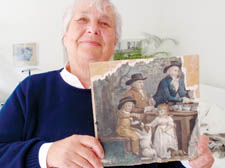|
|
 |
| |

Marian Kamlish with the painting that turned out not to be trash |
A prodigy rescued from
the dustbin of art history
Marian Kamlish, who literally found George Morland among the rubbish, tells Dan Carrier how she went on to write his life story
BOOZING and gambling followed by midnight flits from creditors – artist George Morland’s subjects may have been serene landscapes or fresh-faced children playing games with sticks and hoops, but it did not reflect his turbulent life.
The Camden Town- based painter earned a fortune through his remarkable talent, and then promptly spent it on high living.
But despite being feted by his contemporaries – Sir Joshua Reynolds was a fan and bought his works – Morland has fallen off the art map. Over the past 100 years he has slipped into oblivion.
The 20th-century vogue for modernism in various guises – Cubism, Surrealism – made his quaint images depicting Georgian England appear hopelessly dated.
Prints of his works would be found on place mats in country pubs, and were considered to be low-rent nostalgia. This ignores Morland’s huge talent, and has meant his action-filled life has also been forgotten – until now.
A biography has been published by the Camden History Society. Written by artist and historian Marian Kamlish, it reveals a life that was much more adventurous than the subject matter of his paintings.
Morland earned fortunes through his work and then frittered them away with high living. He had to change his house regularly to avoid creditors, sneaking from cottages in Kentish Town and Camden Town to Hackney, Paddington and back again to Kentish Town. He even fled to the tiny fishing village of Yarmouth in the Isle of Wight during 1799 to escape debts, and was arrested on his return.
Marian first discovered the painter by accident as an art student at St Martins in Holborn in the early 1950s. With paper rationing still in place, art materials were at a premium. She recalls: “I was looking for pieces of cardboard and as I was rummaging through a bin I found an old engraving. I thought it was charming so I kept it. Later, I discovered it was by Morland.”
Marian researched the drawing and discovered that the reputation of the painter behind the engraving had been forgotten.
She said: “I felt he would simply fall off the art map unless someone picked up on him soon. “Not only was Morland a talented artist but he was driven by his social conscience.
“One of his best known works depicted the misery of the slave trade. I was then reading an art book about Camden written in the late 19th-century, and I came across this name, Morland. I started researching his story.”
Marian was delighted to discover he lived around the corner from her home on the corner of Delancey Street and Camden High Street.
“What attracts me to him is he was such a maverick,” she says. “He did not fit the form of an 18th century painter commissioned by the great.”
Morland was born in 1763. His father, Henry, was a painter and the family was well off, living in a grand town house in Leicester Square but, in a pattern that was to repeat itself with his son, Morland senior had a taste for the good life and living beyond his means. He was to lose his family fortune through gambling.
Fortunately, George inherited his fathers gifts as well as his vices. From the age of five upwards he was made to spend hours drawing and painting and by his 10th birthday had been exhibited at the Royal Academy.
It was a talent that was for a time to make him one of the most sought-after artists of the period.
But this early period of his life, filled with serious study, meant Morland never had a proper childhood, according to Marian. Some of his best known works feature children enjoying themselves, with faces full of wonder. “He tried to portray a childhood he had never had himself,” says Marian. He had spent much of his childhood working – he drew horses, carts and dogs for customers at a tea shop to raise cash.
But according to Marian, Morland was a wayward youth – his father was so upset with his laziness that he cast him from the family home with a guinea in his pocket.
The book uses contemporary articles, letters, and dairies to tell Morland’s story. We discover he was denounced as a forger by a neighbour suspicious of the number of copper plates he had with him and the unsavoury hours he kept. He was once held prisoner by a gallery owner in lieu of a debt, and was only released when he had painted works to fill the gallery with.
But his lifestyle also created a man with an acute understanding of the lives of common people. Unlike contemporaries, Morland saw them as perfect for his works.
It also lead him onto having an acute understanding of social issues, and his works became a tool for reform. His painting, Human Traffic, completed in 1787, was the first to depict the horrors of the slave trade.
Morland became a chronic alcoholic, living in the Black Bull pub in Highgate.
His lifestyle was his undoing. He was arrested by a publican in October 1804 over yet another bad debt, and while trying to create a painting to pay the debt off, he had fit and never recovered; his faithful wife, Ann, was so taken with grief she had a “convulsive fit” and died three days after him.
• |
 |
|
 |
 |
|
 |
|


